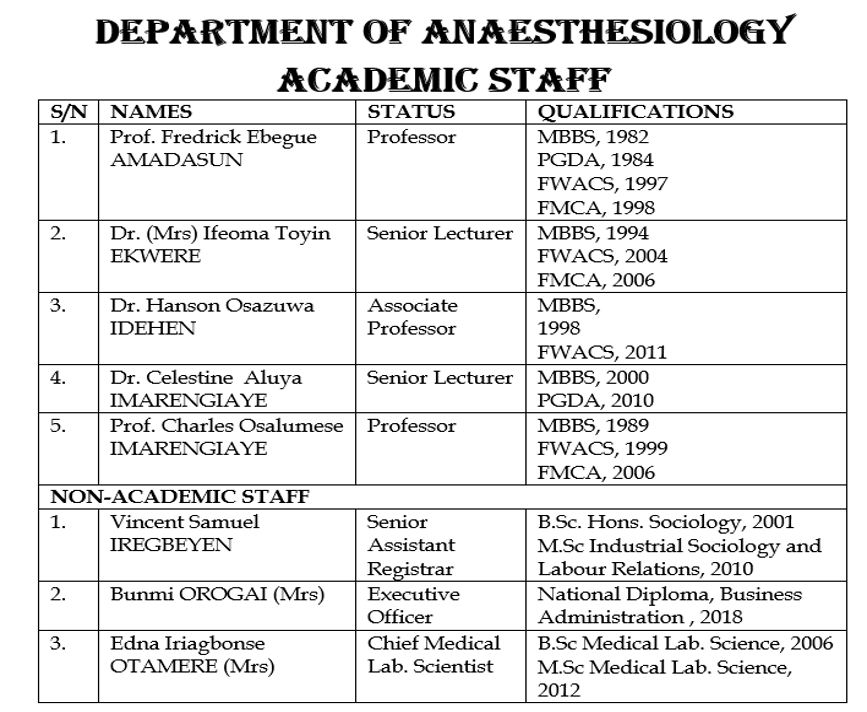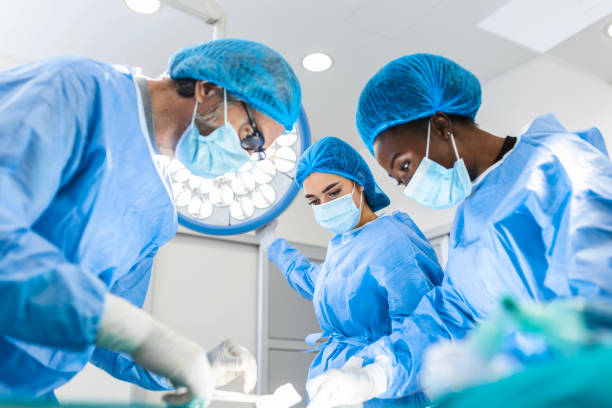
Brief History
The Department of Anesthesiology was established in 1973. It is currently housed in the College Building, University of Benin Teaching Hospital. It presently has four offices and a residents’ room that also serves as a seminar room. More office space would be available when the School of Medicine moves to the new college complex. The Department has a small library besides the College’s medical sub-library. Top grade textbooks and journals are kept in the library for use by staff and students in the department.
Objectives
At the end of his/her training programme in anaesthesiology, the student should have acquired knowledge, skills and attitude that will enable him/her to:
1. Describe the principles of the practice and administration of all forms of anaesthesia and their basic physiological, biochemical and pharmacological background.
2. Administer anaesthesia, both general and local, for minor obstetrical and surgical procedure or in emergencies.
3. Manage cardiac and respiratory arrest.
4. Care for unconscious patients, give the necessary aids and deliver him/her to the nearest health facility safely.
5. Continue his/her further education.
Course Descriptions
(i) This course is undertaken in one posting period of eight weeks during which the students attend lectures, tutorials and are introduced to the commonly used procedures in anaesthesia. A mid-posting test is given at the end of the first four weeks.
(ii) The period ends with a posting examination, the results of which are computed with a final evaluation of the student in surgery. The final examination in Anaesthesiology is included in the final examination in surgery.
Anaesthetic Syllabus
Anaesthesia (3 Credits)
This course deals with the provision of analgesia/anaesthesia for surgical purposes. Sixteen lectures are given, 4 lectures per week and the lectures cover pre-operative care, peri- or intra-operative care and post-operative care. The lectures include the following: Applied Anatomy and Physiology with particular reference to the respiratory, cardiovascular and nervous systems. Also, Pharmacology of the relevant drugs. Physics – the storage of gases and the principles of anaesthetic machines and ventilators – drug interaction and the effect of various kinds of diseases on the response to anaesthesia. General anaesthesia and regional techniques. Two tutorials are given per week and the students are taken on pre-operative ward rounds two times a week. In addition to the above, the students also spend a minimum of two to three hours everyday in theatre and they should be available for emergency cases. The course lasts for 4 weeks, at the end of which the student is assessed – mid-posting examination.
Resuscitation or Reanimation (2 Credits)
The second course is devoted to the principles of resuscitation or re-animation. Eight lectures are given in this course and this covers the relevant areas of Physiology and Anatomy with greater emphasis on oxygen therapy, basic life support and advanced cardiac life support. Practicals are given with the use of models and film shows. In addition to the management of cardiac arrest, shock, the unconscious patient, the lectures also include some drug reactions and their management with particular reference to local anaesthetic toxicity. The resuscitation of near drowning patients are also taught and students are exposed to field exercises in the management of emergencies outside hospital surroundings. The course lasts for 2 weeks, and during this time the student, in addition to the practical demonstrations, continue their theatre sessions. End of course assessment.
Intensive Care Unit and the Treatment of Pain (2 Credits)
The third course is devoted to teaching the principles of intensive care management of patients. Eight lectures are given, covering the areas of the organization of intensive care units, respiratory failure, monitoring of patients, and the more common intensive care illnesses – tetanus, myasthenia gravis, infective polyneuritis, chronic bronchitis, etc. Lectures are also given on theories of pain sensations and the management of intractable pain. The students receive relevant tutorials and are made to see patients in the intensive care area as part of their practical training. End of posting assessment.
Anesthesiology Syllabus
(a) The role of the modern anaesthetist – the history and scope of modern anaesthesia.
(b) Applied respiratory physiology – the determinants of cardiac function, cardiac output and its managements, blood flow to various organs.
(c) Pre-operative assessment- history-taking physical examination, investigations, special illnesses, aims of pre-operative medication, drugs for pre-operative medication.
(d) The anaesthetic apparatus-gas cylinders, reducing valves, flow meters, vaporizers.
(e) Inhalation anaesthetics, other, trilene, halothane, methoxyflurane, uptake, and distribution – indicator and clinical uses.
(f) Intravenous anaesthetic – thiopentone propaniidid, methoxitione, ketamine althesin. Muscle relaxants.
(g) Post-operative care — complications of anaesthesia, positioning monitoring.
(h) Airway problems and intubation – indications for intubation, techniques of intubation, complications of intubation.
(i) Shock – pathogenesis, clinical presentations, treatment.
(j) Narcotic and non-narcotic analgesics indications and complications.
(k) Resuscitation – the pathology of cardiac arrest, principles of cardiac pulmonary resuscitation, after care.
(l) Local anaesthetics – cocaine, nupercaine, marcaine, mepivacaine, procaine, etc.
(m) Drug over dosage—barbiturate and narcotic poisoning, other poisoning, treatment
(n) Obstetric anaesthesia—problems of the pregnant women, technique of anaesthesia complications and management.
(o) Intensive care unit – plan of unit cases for intensive care monitoring, management of special selected cases.
(p) Oxygen therapy – the physiology of oxygen uptake and distribution, types of anoxia, techniques of oxygen administration, high and concentration therapy, catheters, mask oxygen tent and humidification.
Clinical Activities in the Department
The Department delivers anaesthetic services for surgical, obstetric and specialized investigative procedures. Supervises and coordinates the services at the Intensive Care Unit of the hospital and provides epidural analgesia for the relief of pain in labour for desiring patients. The use of medical gases like oxygen in the hospital is managed by the Department.
Course and Programmes
Besides the undergraduate programme, the Department also runs two postgraduate programmes.
1. Postgraduate Diploma in Anaesthesiology
In addition to the undergraduate course in Anaesthesiology, the Department also runs a one-year postgraduate course leading to the Diploma in Anaesthesiology of the University of Benin. To qualify for the course, a candidate must possess MBBS of the University of Benin or an equivalent degree of a recognized university. He/she must also have done the one year housemanship and served an additional year of National Youth service.
Objective
The course is aimed at producing sub-specialist professionals capable of giving routine service in anaesthesia as will be expected in a general hospitals setting. At the end of the course, the student should have acquired the skill to enable him to manage a small anaesthetic department in a general hospital. If it is so desired the student may continue the training to acquire the Diploma or the Fellowship, which would make him a full specialist in the field.
Description of Course
The course lasts for one year beginning from October 1st and ending with a final examination on the first or second week of October the following year. The candidate receives lectures and tutorials and spends most of the time in the theatre where he/she learns basic skills in anaesthesiology. The emphasis is more on the practical aspect of the discipline with enough theoretical background to make the practice sufficiently meaningful.
Facilities
The Department of Anaesthesiology is housed in the College of Medical Sciences building and the University of Benin Teaching Hospital. There is a departmental laboratory for research purposes. It provides routine services to the theatre and the wards. Facilities exist for the estimation of blood gases, osmometary, lung function studies and more routine laboratory investigations. There is also a three-bed intensive care unit providing general intensive care to very ill patients.
Other Relevant Information
The Department is making efforts to progressively computerize its work and services. It hopes to hook up with the internet soonest. In the future, with the availability of relevant manpower, the Department hopes to upgrade the postgraduate diploma programme to a masters degree level.

Recent Comments